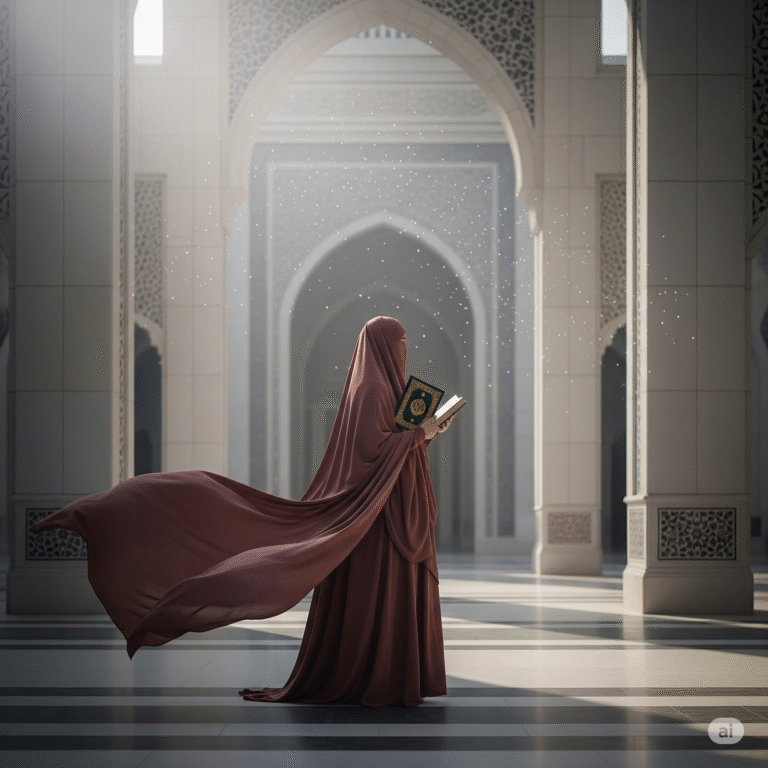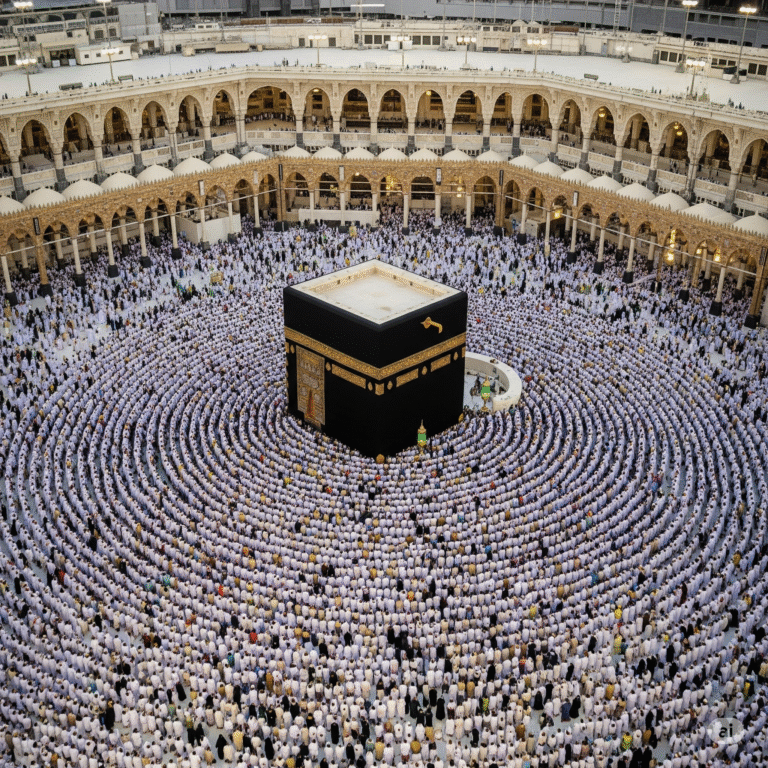Allah Beyond Imagination:
Understanding What the Divine is NOT Like in Islam
The very foundation of Islamic faith rests upon the absolute oneness (\`Tawhid\`) of Allah, the Almighty. This core principle extends profoundly to our understanding of His divine essence and attributes. A question that may naturally arise in curious minds is, “What does Allah look like?” However, the teachings of Islam provide a clear and deeply insightful answer, one that diligently guides believers away from the pitfalls of speculation and towards a more profound appreciation of Allah’s sublime transcendence.
The Unshakeable Principle: Allah is Utterly Unlike His Creation
The Holy Quran itself lays down a fundamental and irrefutable principle that governs our understanding of Allah:
لَّيسَ كَمِثلِهِۦ شَيء وَهُوَ ٱلسَّمِيعُ ٱلبَصِيرُ
“There is nothing like unto Him, and He is the All-Hearing, the All-Seeing.” (Quran 42:11)
This powerful and unambiguous verse unequivocally establishes that Allah is absolutely unique and utterly incomparable to anything within His vast creation. Therefore, any attempt to imagine Allah in finite human terms or to ascribe to Him physical forms that bear resemblance to created beings represents a fundamental misunderstanding of His infinite and transcendent divine nature.
The Inherent Limits of Human Comprehension: The Realm of the Unseen
Our human minds, inherently limited by the scope of our experiences within the created realm, are fundamentally incapable of fully grasping the infinite essence of the Creator. Just as a creature confined to the depths of the sea cannot truly comprehend the existence of a bird soaring through the open sky, our finite intellect cannot possibly encompass the boundless and infinite nature of Allah. The realm of the unseen (\`Ghaib\`) encompasses the true and complete nature of Allah, a reality that utterly transcends our limited sensory perception and cognitive abilities.
As clearly emphasized on the esteemed IslamQA website, the cardinal principle in this matter is unwavering adherence to what has been explicitly revealed in the Holy Quran and the authentic Sunnah (the divinely inspired teachings and practices of Prophet Muhammad, peace and blessings be upon him). Any endeavor to venture beyond this divinely revealed knowledge through mere speculation or subjective personal interpretation invariably leads to misguidance and error.
Steadfastly Avoiding Anthropomorphism (\`Tashbih\` and \`Tamthil\`): A Core Tenet of Faith
Within Islamic theological understanding, profound emphasis is placed on the absolute necessity of avoiding \`tashbih\` (the act of likening Allah to His creation in any manner) and \`tamthil\` (the assertion of any resemblance between Allah and His creation, be it in His divine attributes or His very essence). To ascribe human-like physical features or limited forms to Allah constitutes a grave deviation from the foundational concept of \`Tawhid\`, the absolute oneness of God.
The inherent beauty and profound wisdom embedded within Islamic teachings lie in our acceptance of Allah’s magnificent attributes as they are revealed to us in the Quran and the authentic Sunnah (such as His perfect hearing, all-encompassing seeing, infinite power, and boundless knowledge), without foolishly delving into how these divine attributes are manifested in a manner that bears any resemblance to His finite creation. His attributes are utterly perfect and intrinsically unlike those possessed by created beings.
The Divine Revelations of the Quran and Sunnah (Beyond Human “Looks”)
While the sacred Quran and the Prophetic Sunnah eloquently describe some of Allah’s divine actions, His interactions with His vast creation, and His infinitely perfect attributes, they do not furnish any description of His “looks” in a manner that would permit finite human visualization or comprehension. For instance, we are informed about Allah’s majestic Throne (\`Arsh\`), His divine Hand (Yad\`), His glorious Face (Wajh\`), and His all-seeing Eyes (\`Aynayn\`). However, these are to be understood in a manner that befits His ultimate majesty and absolute transcendence, being entirely distinct from their limited and created counterparts.
As the esteemed scholars meticulously emphasize, these divine attributes are to be accepted precisely as they have been revealed to us, without any form of distortion (\`tahrif\`), outright denial (\`ta’til\`), futile speculation about their precise nature (\`takyeef\`), or any misguided attempt to liken them to the limited attributes of created beings (\`tamthil\` and \`tashbih\`). This disciplined approach, widely recognized as the way of the Salaf (the righteous early generations of Islam), remains the safest, most accurate, and most reverent path to understanding these profound matters.
The Ultimate Blessing: The Vision of Allah in Paradise
Intriguingly, authentic Islamic tradition speaks of the ultimate blessing that will be bestowed upon the believers in Paradise: the sublime vision of Allah Almighty. This unparalleled grace will be the most magnificent reward and an inexhaustible source of profound joy and contentment. However, even this blessed vision, as meticulously described in authentic prophetic narrations, does not entail a complete comprehension of Allah’s infinite essence or any form of likeness to His creation. Rather, it will be a unique, transcendent, and utterly majestic experience granted solely by His infinite grace and mercy.
Steadfastly Guarding Against Speculation: Embracing the Path of Submission
In all matters concerning Allah’s divine essence and His perfect attributes, the most righteous and secure path for a believer is that of humble submission (\`Islam\` itself literally signifies submission to the will of Allah). We willingly submit to that which Allah and His divinely inspired Messenger (peace and blessings be upon him) have revealed to us, humbly acknowledging the inherent limitations of our finite human understanding. Engaging in baseless speculation or allowing our limited imaginations to conjure up images of Allah based on our own restricted experiences can tragically lead to grave errors in our core beliefs.
The profound wisdom inherent in this disciplined approach is manifold. It diligently protects the absolute sanctity of Allah’s ultimate majesty, firmly reinforces His utter uniqueness and incomparability, and steadfastly keeps our hearts and minds focused on His sincere worship and devoted obedience, all grounded in divinely revealed truth rather than the shifting sands of human conjecture.
Finding Profound Awe and Reverence in the Unseen Majesty
Instead of futilely attempting to define that which inherently lies far beyond the grasp of our limited human comprehension, we are divinely encouraged to find profound awe and deep reverence in Allah’s magnificent and intricate creation, His infinitely perfect attributes, and His boundless and absolute power. Recognizing and humbly accepting the inherent limitations of our understanding should never diminish the strength of our faith but rather serve to deepen our profound appreciation for the One and Only who is utterly unlike anything that our finite minds could ever possibly conceive.
Therefore, by steadfastly adhering to the clear and unambiguous guidance provided by the Holy Quran and the authentic Sunnah of His final Messenger (peace and blessings be upon him), and by diligently avoiding the treacherous pitfalls of anthropomorphism and baseless speculation, we can cultivate a sound and robust understanding of Allah’s ultimate transcendence and magnificent majesty, thereby enriching the very core of our faith and drawing us ever closer to Him through sincere worship, devoted obedience, and unwavering trust in His infinite wisdom.
Keywords: Allah’s appearance in Islam, how does Allah look like, seeing Allah, attributes of Allah, anthropomorphism in Islam, \`Tawhid al-Asma’ wa’l-Sifat\`, Islamic theology, Allah is unlike His creation, Quran on Allah’s appearance, Sunnah on Allah’s appearance, IslamQA Allah’s appearance.




